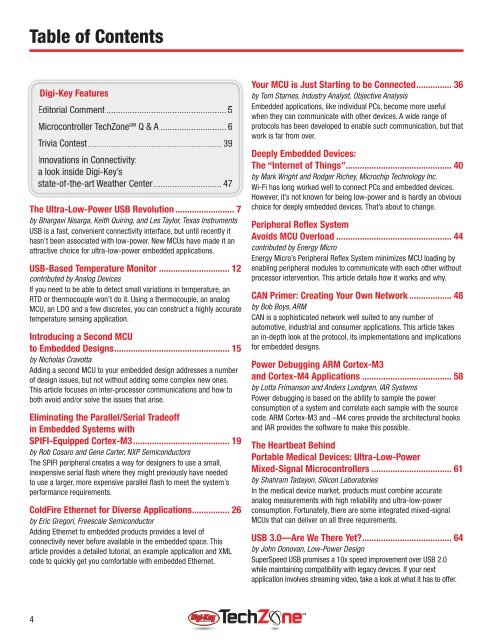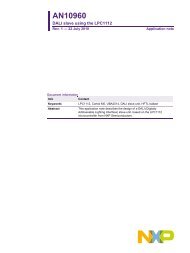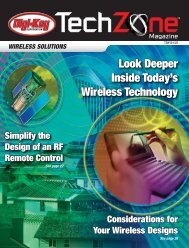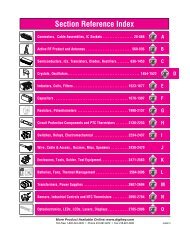Microcontroller Solutions TechZone Magazine, April 2011 - Digikey
Microcontroller Solutions TechZone Magazine, April 2011 - Digikey
Microcontroller Solutions TechZone Magazine, April 2011 - Digikey
Create successful ePaper yourself
Turn your PDF publications into a flip-book with our unique Google optimized e-Paper software.
Table of Contents<br />
Digi-Key Features<br />
Editorial Comment ................................................... 5<br />
<strong>Microcontroller</strong> <strong>TechZone</strong> SM Q & A ............................<br />
6<br />
Trivia Contest ......................................................... 39<br />
Innovations in Connectivity:<br />
a look inside Digi-Key’s<br />
state-of-the-art Weather Center ............................. 47<br />
The Ultra-Low-Power USB Revolution ......................... 7<br />
by Bhargavi Nisarga, Keith Quiring, and Les Taylor, Texas Instruments<br />
USB is a fast, convenient connectivity interface, but until recently it<br />
hasn’t been associated with low-power. New MCUs have made it an<br />
attractive choice for ultra-low-power embedded applications.<br />
USB-Based Temperature Monitor .............................. 12<br />
contributed by Analog Devices<br />
If you need to be able to detect small variations in temperature, an<br />
RTD or thermocouple won’t do it. Using a thermocouple, an analog<br />
MCU, an LDO and a few discretes, you can construct a highly accurate<br />
temperature sensing application.<br />
Introducing a Second MCU<br />
to Embedded Designs ................................................. 15<br />
by Nicholas Cravotta<br />
Adding a second MCU to your embedded design addresses a number<br />
of design issues, but not without adding some complex new ones.<br />
This article focuses on inter-processor communications and how to<br />
both avoid and/or solve the issues that arise.<br />
Eliminating the Parallel/Serial Tradeoff<br />
in Embedded Systems with<br />
SPIFI-Equipped Cortex-M3 ......................................... 19<br />
by Rob Cosaro and Gene Carter, NXP Semiconductors<br />
The SPIFI peripheral creates a way for designers to use a small,<br />
inexpensive serial fl ash where they might previously have needed<br />
to use a larger, more expensive parallel fl ash to meet the system’s<br />
performance requirements.<br />
ColdFire Ethernet for Diverse Applications ................ 26<br />
by Eric Gregori, Freescale Semiconductor<br />
Adding Ethernet to embedded products provides a level of<br />
connectivity never before available in the embedded space. This<br />
article provides a detailed tutorial, an example application and XML<br />
code to quickly get you comfortable with embedded Ethernet.<br />
Your MCU is Just Starting to be Connected ............... 36<br />
by Tom Starnes, Industry Analyst, Objective Analysis<br />
Embedded applications, like individual PCs, become more useful<br />
when they can communicate with other devices. A wide range of<br />
protocols has been developed to enable such communication, but that<br />
work is far from over.<br />
Deeply Embedded Devices:<br />
The “Internet of Things” ............................................. 40<br />
by Mark Wright and Rodger Richey, Microchip Technology Inc.<br />
Wi-Fi has long worked well to connect PCs and embedded devices.<br />
However, it’s not known for being low-power and is hardly an obvious<br />
choice for deeply embedded devices. That’s about to change.<br />
Peripheral Reflex System<br />
Avoids MCU Overload ................................................. 44<br />
contributed by Energy Micro<br />
Energy Micro’s Peripheral Refl ex System minimizes MCU loading by<br />
enabling peripheral modules to communicate with each other without<br />
processor intervention. This article details how it works and why.<br />
CAN Primer: Creating Your Own Network .................. 48<br />
by Bob Boys, ARM<br />
CAN is a sophisticated network well suited to any number of<br />
automotive, industrial and consumer applications. This article takes<br />
an in-depth look at the protocol, its implementations and implications<br />
for embedded designs.<br />
Power Debugging ARM Cortex-M3<br />
and Cortex-M4 Applications ...................................... 58<br />
by Lotta Frimanson and Anders Lundgren, IAR Systems<br />
Power debugging is based on the ability to sample the power<br />
consumption of a system and correlate each sample with the source<br />
code. ARM Cortex-M3 and –M4 cores provide the architectural hooks<br />
and IAR provides the software to make this possible.<br />
The Heartbeat Behind<br />
Portable Medical Devices: Ultra-Low-Power<br />
Mixed-Signal <strong>Microcontroller</strong>s .................................. 61<br />
by Shahram Tadayon, Silicon Laboratories<br />
In the medical device market, products must combine accurate<br />
analog measurements with high reliability and ultra-low-power<br />
consumption. Fortunately, there are some integrated mixed-signal<br />
MCUs that can deliver on all three requirements.<br />
USB 3.0—Are We There Yet ...................................... 64<br />
by John Donovan, Low-Power Design<br />
SuperSpeed USB promises a 10x speed improvement over USB 2.0<br />
while maintaining compatibility with legacy devices. If your next<br />
application involves streaming video, take a look at what it has to offer.<br />
4














